Outcome Report of
National Networked Digital Library, Indonesia
CCOHS Project Number: 001.1.2
Reporting Period: November 24, 2000 - November 24, 2001
By Ismail Fahmi, ST - ismail@itb.ac.id
A project undertaken by Computer Network Research Group (CNRG) and Knowledge
Management Research Group (KMRG) ITB, funded by IDRC Canada under its Pan Asia
Networking R&D Grants Program. Web site: http://idln.itb.ac.id
and http://gdlhub.indonesiadln.org.
Abstract
This project, national networked digital library in Indonesia, initially had
objectives that were limited only for research and education (university)
institution. Resources that will be managed were only research reports, theses,
and dissertation. And the expected impact also were limited to increase the
utilization of researches result and to push the electronic scholarly
publishing.
But in the first seminar and workshop for the socialization of its idea,
people suggested not to restric this effort on such objectives only. Many non
research and education institution also showed their interest to join the
network, such as from NGO, high school, bussiness, public organization, and so
on. Finally we tried to accomodate their interest and broaden the scope of
institution that can join the network and the resources type that will be
managed.
The results was very impressive. We established the Indonesian Digital
Library Network (IndonesiaDLN) community. Partners of the network can be from
personal, internet cafe, and any institution or organization. Any types of
knowledge are accepted. And finally this network seems to have an ambitious
mission: connecting people's knowledge and creating one
(distributed-and-networked) big national memory.
Ganesha Digital Library is one of this project result. It is the first
web-based digital library application that will be distributed as an open-source
in Indonesia. People can get the source code and install the application in
their computer freely but in one condition: They should agree to share their
knowledge that are managed using GDL to human being within IndonesiaDLN. This
condition is one of our campaign about knowledge sharing.
GDL will become the application that will be installed for IndonesiaDLN hub
server and GDL Hub server. It also can be configured for personal, internet
cafe, and institution purposes wheter with dedicated or temporary connection.
This is one of our strategy to disseminate and utilize knowledge to our nation:
give the easiest and personal touch way for people in joining the network.
Since its launching on June 2001, recently IndonesiaDLN has 25 institutions
successfully join the network and more than 60 individual and institutions
registered to be partners. Our paper about the born of IndonesiaDLN and its
achievement has won the first prize at an international paper contest by
American Society for Information Science and Technology (ASIST). Our
presentation about this regional technology, the bottom-up effort, and the fact
that many institutions getting interested to join the network have gain the
ASIST participants' interest.
Objectives
The objectives of this project are:
- develop a digital library network system that suitable
for internet infrastructure of developing countries especially Indonesia;
- develop an Indonesian Digital Library Network (IDLN);
- facilitate efforts of universities to develop their own
digital library system and to have students and researchers submit their
research reports, theses, and dissertations;
- install and operate IDLN servers so that students,
researchers, and others engaged in scholarship can search, browse, and
retrieve electronic reports;
- prepare training and course material to support the
development of IDLN;
- push
forward the revolution in electronic scholarly publishing so that it may
lead to universities playing a more active and cost-effective role in the
production, organization, preservation and dissemination of knowledge
Related Previous Activities
This project can't be separated from its previous activities. The
development of digital library by ITB actually have been started since in the
middle of 1999 (version 1.0 and 2.0). And at the beginning of 2000, the
development of Ganesha Digital Library (GDL) version 3.0 is started. This
version become the major part of further development of digital library system
in this project.
The following are activities undertaken related to GDL version 3.0 and the
establishing of IndonesiaDLN.
- Adopting Dublin Core Metadata Standard.
In GDL version 1 and 2, we didn't use any standard for metadata. Starting
from version 3.0 we want to adopt the widely used metadata standard for
electronic resources. It is Dublin Core Metadata Element Set Version 1.1.
This will lead to the opportunity of international collaboration for digital
library network.
- Writing the Code
The design of GDL 3.0 system was completely different from its former
version. We should rewrite the code from scratch. The code was in PHP
scripting language.
- Test Bed and Implementation
GDL 3.0 was successfully tested and implemented on top of FreeBSD server
box. The server application were using Apache web server, mysql database
server, dan swish-e search engine. We used qmail as the mail transport agent
for more reliability and security.
Ten librarians of ITB Central Library were trained to operate the system
such as for administrator, knowledge officer, administrator, digitizer, and
operator. During this experiment, they uploaded collection of research
reports, final projects (undergraduate), theses, and dissertations. We also
tried to upload multimedia file such as audio and video.
The URL of the digital library server is http://digilib.itb.ac.id.
(Currently running GDL version 3.1)
- Developing IndonesiaDLN Web Site
Although this project administratively just started on November 2000, we
have done some important activities several months before. On August 2000,
web develop IndonesiaDLN web site to disseminate the idea, activities, and
progress of this project. This web site was very usefull for Indonesian
librarian and IT engineer that want to collaborate with us in developing
digital library network.
The site was carried out with the help of aid from IDRC and YLTI. The URL is
http://idln.itb.ac.id.
- Launching and National Seminar
At October 2, 2000, ITB First Vice Rector launched the digital library web
site in a national seminar of digital library. The seminar was held by ITB
Central Library jointly with CNRG and KMRG ITB. About 250 participants from
all over Indonesia attended the seminar.
It was a very good chance to disseminate the result of the project and to
spread the idea of developing National Networked Digital Library in
Indonesia. Principal investigator of this project (Ismail Fahmi) gave
presentation about progress of Ganesha Digital Library and objective of the
project to develop the network. As the follow up, a two days meeting was
held after the seminar.
- Meeting for Establishing IndonesiaDLN
After the seminar we held a meeting that was attended by 40 representatives
from 23 research and education institutions in Indonesia. The meeting was
very important because resulted the following agreements:
- Establishing a community named Indonesian Digital Library Network or
IndonesiaDLN. The abbreviation of IDLN has been exist for Indonesian
Distance Learning Network. So then we used IndonesiaDLN for this
network.
- Elect the general secretary (Ismail Fahmi) and the office of
IndonesiaDLN at ITB.
- Using Dublin Core Metadata Element Sets Version 1.1 as the base of IndonesiaDLN Metadata Standard.
- Approving IndonesiaDLN Metadata Standard to be used by any digital
library application within IndonesiaDLN.
- Using XML format for data interchange among digital library servers.
The complete result of this meeting can be downloaded from http://idln.itb.ac.id/meeting/Oktober2000/IndonesiaDLN-hasil-meeting-2okt2000.pdf
(132 kb).
- Getting Funding for Implementation of Digital Library at Eastern
Indonesian Universities (EIUDLN)
The meeting also was attended by representatives from three institutions at
Eastern Indonesia; University of Cendrawasih Irian Jaya, University of
Hasanuddin Makassar, and University of Haluoleo Kendari. Mr. Nello Angerilli
from EIUDP/CIDA-Project also attended the meeting.
In the meeting we had a limited discussion with them, and we came to an
agreement to develop digital library network at the universities with the
aid from EIUDP/CIDA-Project.
We did the activities as part of this project, although the Memorandum of
Grant Condition with IDRC just signed up on November 2000. It was because the
most important event of this project to develop National Networked Digital
Library in Indonesia was done there.
Activities Undertaken During the 12 Months
Since November 24th, 2000 until November 23th, 2001 we have done the following
activities:
- Registering internet domain for IndonesiaDLN
Domain name for IndonesiaDLN is IndonesiaDLN.org. We have registered
the domain and the primary DNS server is located at ITB Central Library. The
IndonesiaDLN hub server, GDL Hub server, and other related server of
IndonesiaDLN will use the domain. Such as gdlhub.IndonesiaDLN.org, hub.IndonesiaDLN.org,
www.IndonesiaDLN.org, and
so on.
- Procurement of PC Workstation
We have procured three personal computers to support development of GDL,
creating CD-ROM, researching multimedia techniques for knowledge
distribution, and for administration of GDL-Network and IndonesiaDLN Hub
server. These workstations are located at KMRG ITB lab within ITB Central
Library.
- Designing GDL 3.1 to support IndonesiaDLN Metadata Standard
We have changed the design of GDL 3.0 to be more portable, easy to implement
and replicate, and of course support IndonesiaDLN Metadata Standard. GDL 3.1
now fully utilizes the database access to create and display metadata,
create directory tree, and search. GDL 3.1 also should be expandable to
support large hard disk capacity (scalability).
GDL 3.1 can be installed on Windows 9x/NT/2000 and on Linux/Unix server. We
keep using server application such as apache, mysql, and php.
- Designing GDL-Network System
We have some consideration in designing networking system for GDL-Network,
namely:
- condition of telecommunication infrastructure in Indonesia (internet
bandwith and availability)
- existing infrastructure of computer and network within our community
- psicological aspect of the system that should able to attract poeple
to join IndonesiaDLN and share their knowledge.
From above considerations, we developed the following design:
- GDL-Network is a network of digital library servers that use GDL as
the application.
- There will be a GDL Hub server at central side that acts as a
concentrator and moderator for communication among GDL partner servers.
- There will be GDL partner server at partner side that will be used to
manage their (community's) knowledge.
- There will be GDL partner server for personal, internet cafe, and
institution.
- Communication between GDL Hub and Partner will use HTTP and/or SMTP
protocol.
- GDL will support roaming membership. It means user can register to be
a member from any GDL partner server, and they can use the account at
any GDL partner servers without have to register again.
- CD-ROM transfer will be used as communication media between hub and
partner that have no internet connection (ie at rural area).
- Designing Interchange Protocol Using SMTP and HTTP
There are two mode of data interchange protocol between GDL Hub and Partner,
that are SMTP and HTTP mode.
SMTP protocol will be implemented on Unix platform. If partner uses unix box
for GDL, data synchronization can be done automatically without need any
administrator involvement.
HTTP protocol will be implemented for both unix and windows. Administrator
(personal, internet cafe, or institution) can do synchronization via web
pages. Both hub and partner servers will communicate on administrator's
demand using HTTP connection.
Information that will be synchronized are metadata, files, publisher, and
membership. By membership synchronization, member will gain the roaming
membership facilities.
- Writing the Code and Web Design
Most of codes in GDL 3.1 are written from scratch to fit the design
requirements. Some modules are taken from previous version. Web code are
using PHP scripting language with XML and GD (gif drawing) modules are
enabled. Web design uses simple and minimal model. User can access the pages
fast and easily.
Communication protocol using SMTP are being developed using C++ language.
We use windows 98 and Unix FreeBSD operating system during the system
development.
- Debugging and Testing
Bugs always appear time by time. We spent most of the time to find the bugs
and fix them. GDL 3.1 has been tested on windows 98 and Linux/Unix
FreeBSD.
We have successfully tested the operation of client-server communication
using HTTP protocol. While the SMTP protocol communication is not finished
yet. Test bed has been done for synchronization between ITB Central Library
DL server and GDL Hub (in the same network) and between University of
Muhammadiyah Malang (East Java) and GDL Hub (West Java). Metadata from the
university has successfully uploaded into GDL Hub using HTTP protocol.
- Procurement of Servers
We have procured two servers for GDL Hub server and IndonesiaDLN Hub server.
Both servers will act as backup each other. Currently the servers will be
placed at AI3 (Asian Internet Interconnection Initiatives) ITB NOC. In the
future we plan to offer cooperation with ISP that interested to provide free
server hosting for the server.
Specification of the servers are similar, that is:
Mainboard Intel Serverboard STL2
Dual Processor Intel P!!! 933Mhz
ECC SDRAM 256MB
Hard drive Seagate Barracuda SCSI 18GB
Hard drive Seagate Barracuda IDE 40GB
- Distributing GDL Brochure
We made a brochure of GDL both printed (lux) and electronic to be
disseminated nationally. The brochure will be published initially on the
seminar (6-7 June 2001). Electronic version of the brochure can be
downloaded at http://gdlhub.indonesiaDLN.org/doc/brosur-gdl31.pdf.
- Creating CD-ROM Distribution of GDL
GDL will be distributed as open-source. The source code of GDL totally is
only about 2 MB. But for user confenience we include the apache, mysql, and
php source code and binary in the CD-ROM both for windows and unix.
Although it is an open-source, we don't place the source-code of GDL openly
at an FTP server. People that want to get the code have to submit an
application form. They have to sign that they agree to share their knowledge
managed using GDL into IndonesiaDLN. Information about getting the source
code can be found at http://gdlhub.IndonesiaDLN.org/faqgdl.php.
- 6-7 June 2001, 2nd Seminar of IndonesiaDLN
We have hold the 2nd Seminar of IndonesiaDLN at Santika Hotel, Bandung. Information about this seminar and workshop can
be found at http://idln.itb.ac.id.
In the seminar, we launched the IndonesiaDLN network. We described the
vision, strategies, and practical aspect of IndonesiaDLN, and open the
registration to become IndonesiaDLN partner. The seminar was attended by
more than 150 participants from the whole Indonesia. We also have
three international speaker from British Council, NUS Singapore, and SCCH
Austria.
- 8-9 June 2001, 2nd Workshop of IndonesiaDLN
The second workshop was held at Rossan Hotel, Lembang Bandung. About 60
participants attended the workshop. In the workshop, we met the IndonesiaDLN partners to discuss metadata
standard, current application of digital library, the organization,
membership, and so on. We also have successfully done the metadata
interoperability test between GDL and New Spektra (digital library software
by Petra University).
The workshop wasn't agree to establish an organization form for IndonesiaDLN
like consortium, association, etc. At this time, we were agree to work
together within IndonesiaDLN as a forum. But in the next meeting - proposed
to be on March/April 2002 - we will discuss this organizational form
seriously.
- June - November 2001, The IndonesiaDLN Socialization, Talk, and
Presentation
During this period, we have done a sequence of talks and presentations about
IndonesiaDLN at some institutions in Indonesia and some international
events. The following is the list of the institutions:
- June 16: Islamic University of Bandung, Bandung
- June 27: Lontar Foundation, Jakarta
- June 28: The Library of The Indonesian Health Department, Jakarta
- July 4: Badan Tenaga Atom Nasional, Jakarta
- July 6: Department of Biology of ITB, Bandung
- July 10: National Library of Indonesia, Jakarta
- July 12: University of Yarsi, Jakarta
- July 12: Library Science Department of University of Indonesia,
Jakarta.
- July 17: Inter-university Center for Microelectronic of ITB,
Bandung.
- July 19: The National Banking Institutue (Perbanas), Jakarta.
- August 10: KTSJ Farmer Cooperation, Bandung.
- August 14: National Electric Company (PLN), Jakarta.
- August 20 - 23: Asia Pacific Advanced Network (APAN), Penang,
Malaysia.
- August 24 - 28: Penang Library Network, Penang, Malaysia.
- September 10 - 12: the 3rd International Information and Data
Integration Workshop (IIWAS), Lintz, Austria.
- October 7: Kids Reading Group Arcamanik (PBA), Bandung. The result
was to support the group and other kindergarten group with a digital library
network system for children.
- October 8: Center of Technology Training for Teacher (PPPG
Teknologi), Cimahi.
- October 22: Presentation of IndoesiaDLN to PT Naver Indonesia,
Bandung.
- October 31: Workshop of Network of Indonesian Agricultural
Researcher (JPPN), Bandung. The result was to make a cooperation between
KMRG and JPPN in developing information system network for agricultural
player (SME) and research.
- November 4 - 7: Annual meeting of American Society for Information
Science and Technology (ASIST), Washington, DC, USA.
- November 8: Presentation at The World Bank in front of the IT
Division, Washington, DC. USA.
- November 8: Meeting with infoDev director, Washington, DC. USA.
- November 16: Final report presentation at YLTI, Foundation of
Telecommunication and Information Research, Bandung.
- November 21: PT Myohdotcom Indonesia, Jakarta.
- July - September 2001, Installation of GDL at EIUDLN, Eastern Indonesia
Universities Digital Library Network
KMRG has been appointed by EIUDP to install the GDL at three institution
which are located at eastern of Indonesia, namely: Uncen, Unhalu, Unsrat.
- September - November 2001, Installation of GDL at 11 Indonesian Islamic
Institutes (IAIN)
KMRG has been appointed by McGill to develop IAIN library networking using
the GDL application. The institutions are located at all big islands such as
Sumatra, Java, Kalimantan, and Sulawesi. We have finished the installation
and training, and the work will be continued with the monitoring and
management.
- October - November 2001, Cooperation with PT Naver Indonesia for the
Search Engine
During this months, we have an intensive discussion with PT Naver
Indonesia (a branch of Naver company at Korea), to develop search engine for
IndonesiaDLN using Naver Search Engine for free. An MOU between KMRG and
Naver Indonesia will be signed.
- November 2001, Cooperation with PT MyohDotCom Indonesia to support the
Warintek 9000 program
Warintek is the program of Ministry of Research and Technology of Indonesia,
to develop 9000 internet centers in Indonesia until 2004. PT MyohDotCom is
one of the company that will implement the plan. The company is interested
to integrate the GDL into its installation package. If we could come into an
agreement, an MOU will be signed.
- November 2001, Paper by Ismail Fahmi entitled "IndonesiaDLN is
Born to Struggle with The Digital Divide" has won the first prize from
ASIST International paper contest.
This is one of our pride that our effort, methodology, and achievement have
gain an international acknowledgement. This give us a new spirit to develop
and maintain the network in order to can give real benefits to people.
- November 2001, Starting a collaboration with the NDLTD, Networked
Digital Library for Theses and Dissertation, Virgina University
As result of the ASIST meeting, KMRG will start a collaboration with the
NDLTD in establishing digital library network between IndonesiaDLN and NDLTD,
using the OAI protocol.
Other Related Activities During the Initial 12 Months
Besides above activities, we note some activities that related to this
project. The following are titles of the activities:
- Cooperation with Indonesian Legal Aid Institution and EIUDP to develop
system for Human Right Network. This network will be integrated with
IndonesiaDLN network.
- Signing MOU with YLTI to develop Networked Information System for SME.
This effort will be integrated with IndonesiaDLN network.
- Signing MOU with McGill for Survey and Consultation on developing digital
library network among IAIN, Islamic Religion Institutions.
- Conduct site survey for 11 IAINs.
- Present the survey report to McGill and MORA (Ministry of Religion Affair)
of Indonesia.
- Procurement of equipment for EIUDLN.
- Pre-Installation of GDL for EIUDLN.
- August 3-5, 2001, Meeting with YLBHI and EIUDP to finalize the
proposal for Indonesian Human Rights Information System (IHRIS). The
proposal will be submitted to CIDA and other international funding agency.
- July - November, 2001, Discussion with Mutiara Bunda
Playgroup/Kindergarten and PT StarKids to establish a cooperation in making
the VCD version of children education for teachers and parent. The content
will be based on the Mutiara Bunda daily activities of the playgroup and
kindergarten.
- November 16, 2001, Presentation of N21-SME interim project report
to YLTI. YLTI agree to extend the development of agriKnow (the software
for SME information system network based on GDL Engine) until May 2002. YLTI
also asked KMRG to submit further proposal for implementation of agriKnow on
fields.
Results Obtained
The following is table of the results obtained during the activities
according to the expected outcomes as stated in the project proposal.
| No |
Outcome types |
Expected |
Fact |
| 1 |
Standardization |
Standard for:
- Metadata and classification
- Submission, authentication, and dissemination process
|
Achieved:
- Metadata Standard for IndonesiaDLN based on Dublin Core Metadata
Element set version 1.1 was approved.
- Revision for the IndonesiaDLN Metadata Standard has been proposed
(June 2002).
Not implemented:
- Classification of categories and subject is not practical. No
standard was approved for this subject.
- Submission, authentication and dissemination are vary according to
the system and environtment. Developing a standard for this is not
practical.
Conclusion:
- This outcome is considered to be achieved.
|
| 2 |
Servers |
Servers that will be installed and operated:
- A central server at AI3 ITB NOC.
- 7 partner servers at: Pasca Sarjana ITB, ITB Central Library,
Research Institute of ITB, University of Brawijaya Malang, University
of Muhammadiyah Malang, IAIN Sunan Ampel Surabaya, University of
Cendrawasih Irian Jaya.
|
The installed servers:
- 2 central server at AI3 ITB NOC: GDL Hub server and IndonesiaDLN
Hub server.
- 25 partner servers are successfuly connected to the network.
- 12 IAIN have joined to be partner.
- 60+ institution and individual have registered to be partner.
Conclusion:
- This outcome is excel the target.
- It shows that many Indonesian institutions (research, education,
etc) are interested to join this efforts.
- It is a good weather for the future of IndonesiaDLN.
|
| 3 |
Organization |
- A central
agency will be established to organize the operational and
administration of the network. The central agency will be in ITB.
- Other
agencies or representations will be established in each partner that
install and operate a partner server (i.e. at Unibraw, UMM, IAIN,
and UNCEN).
- The coordination of all agencies especially for
information exchange and library network will be established and managed
by the central agency.
|
Achieved:
- IndonesiaDLN was established as an open community of digital
library network in Indonesia. The central administration office is
located at KMRG ITB.
- Members of IndonesiaDLN are not limited to research and education
institution. Even any organization or individual are welcame to join
this network.
- Workshop on June 2001 only agree to setup IndonesiaDLN as an open
forum.
Not yet achieved:
- A more formal organizational form of IndonesiaDLN will be discussed
on next workshop (April 2002)
Conclusion:
- Half of the expected outcome has been achieved.
- The rests are expected to be achieved later.
- Scope of the involved partner is widened.
|
| 4 |
Collections |
At
the end of the project, we estimate the participation from students
and researchers will be:
- At least 5%
of full text of final reports, theses, and dissertations of
a graduation period of ITB during the project will be submitted into
central server.
- At least 5% of full text of research reports
managed by Research Institution (LP) of ITB will be uploaded into
central server.
|
Achieved:
- Currently, knowledge type that will be managed by IndonesiaDLN are
not limited to research reports, final projects, theses, and
dissertations. But at this moment, such resources will dominate the
collections.
- Type of collections that will be managed: Undergraduate Theses,
Master Theses,
PhD Theses,
Article/Grey literature,
Clipping,
Course Material,
Distance Learning,
Examination & Quiz Sample,
Expertise Directory,
Free e-Books,
Internet Directory,
Journal,
Multimedia,
Proceeding,
Publication,
Research Report, and Heritage.
- Current collections are about 3500+ title totally. Most of them are
gray literature, research reports, theses, dissertation, and multimedia.
- Partners have shown their contribution to share their institution's
knowledge.
Not yet achieved:
- Submission has not widely done by students, but mostly by librarian.
It seems that we have to establish a cultural policy for knowledge
management at every institution.
Conclusion:
- The target for collection captured should be revised. It's not only
about collection at ITB, but many partners have join the network
and have share their knowledge.
- Socialization of the digital library services should be done
attractively to communities member. A cultural action will be defined
and deployed.
|
| 5 |
Dissemination |
- Other
installed partner servers will be able to replicate the
database from central server for their local dissemination.
- Dissemination using CD-ROM will be done
for eastern Indonesia universities.
|
Achieved:
- 25 partners have successfully share their contents.
- Personal and Internet Cafe partner server also have been able to
download metadata using HTTP protocol.
- Many institutions and individuals have request for CD-ROM containing
the source code of GDL, even though they can download from the web.
Not yet achieved:
- CD-ROM dissemination to the 'off-line' servers. Currently, there is
no request for this service.
Conclusion:
- Partners more like to download the content using
synchronization facility rather than using CD-ROM..
|
Ganesha Digital Library Features
The following are lists of GDL features:
- Distributed Knowledge Management
- Centralized Knowledge Distribution
- Online Member Registration
- Roaming Membership
- Search and Browse
- Category-based Organization
- Upload Metadata and Files
- Personal Directory
- Review Forum
- Access Restriction
- Image Thumbnail
- Knowledge Organization
- News
- Synchronization
- Member and Group Administration
- Advertisement
- Dublin Core / IndonesiaDLN Metadata Compliant
- XML Based Transaction
- Running on CD-ROM
The
Mother Network of The Digital Library Networks
There
are other efforts such as the Digital Heritage Network, SME/ Agriculture
Network, Human Right Information Network, Bibliographic Network, and Distance
Learning Network. All of these networks can be integrated under IndonesiaDLN
easily as long as they use IndonesiaDLN Interoperability Metadata Standard for
exchange.
Architecture
of the IndonesiaDLN
Figure
1 bellow describes how the above stated networks will be integrated under
IndonesiaDLN.
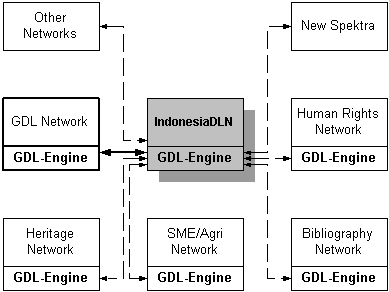
Figure
1.
Architecture of IndonesiaDLN as Mother network of digital library networks
From
figure 1 above we can see many networks can be integrated into one big network.
For this purpose, GDL –Ganesha Digital Library- will be developed to become
the main engine of the Network. GDL is now being developed modularly so that it
can be used for different environments and purposes.
The
most important part of the software is the GDL-Engine that will provide
facilities and services to develop a web-based digital library. The services
would be: membership, personal directory, authentication, search engine, content
browsing, and the exchange protocol. The most important service is the exchange
protocol.
The
Working Network
IndonesiaDLN
was launched last June 2001. The first network under IndonesiaDLN is GDL-Network.
It is assorted of the digital library servers that use GDL as their server
application software.
For
this moment, there is only one hub server, namely GDL-Hub that acts as the
mediator among the digital library servers. There are 13 digital library servers
under GDL-Network, and more than 15 institutions are in progress of developing
their digital library server using GDL. Most of the servers are running on
Microsoft Windows 98/2000 and another are on Linux and FreeBSD. They connect to
GDL-Hub using dial-up and dedicated internet connection.
GDL
also can be installed behind proxy. The collections still can be synchronized
with the GDL-Hub and the server also can download the metadata from the Hub.
This feature enable installation of GDL at internet kiosks to wider the
distribution of information.
Works
in Progress
We
are now in progress of developing digital library system for heritage, human
rights (NGO), and SME –the Small and Medium scale Enterprises. We are also
planning for the development of digital library network for distance learning.
All of these networks are based on GDL-Engine.
Human
Rights Digital Library Network is developed by KMRG ITB in cooperation with
EIUDP –the CIDA project for the eastern Indonesian universities, Simon Fraser
University Canada, YLBHI –the Indonesian Foundation for Human Rights, and CNRG
ITB. While SME Digital Library Network is developed by KMRG ITB in cooperation
with YLTI and PPAU-Ilmu Hayati ITB.
Each
of the networks will have a Hub server and then will be integrated into
IndonesiaDLN Hub server. Using any digital library application, users can access
any type of information provided by the IndonesiaDLN. User with Heritage Digital
Library application can download and read information delivered by other users
that use SME Digital Library application, and vice versa. This interoperability
is possible along using the IndonesiaDLN Metadata Standard.
Latest
Status of IndonesiaDLN
The
growth of IndonesiaDLN is counted to be very fast. Only in two months after its
lunching, the number of registered partners is reached 43. From this number, 14
of them have successfully connected to GDL-Hub and shared their electronic
collections. The number is keep increasing by now.
Partner
and Identifier
A
Partner is a personal or an institution that installs a digital library server
and joins IndonesiaDLN to share the electronic collections. Everybody can
download and install GDL software, but to become a partner of IndonesiaDLN, s/he
has to register first.
Every
partner has Publisher_ID that is obtained after registering its server to
IndonesiaDLN/GDL-Network administration. Publisher_ID is very important because
it becomes identity of the server and part of identity for every record
disseminated to the network. Publisher_ID consist of Area Code, Type of Library,
and Name of Institution or Individual. For example JBPTITBPP consists of:
JB
= Jawa Barat (West Java, Area)
PT = Perguruan Tinggi (Higher Education, University, or Institute)
ITB = Institut Teknologi Bandung (Name of the Institution)
PP = Perpustakaan Pusat (Central Library, sub-name of the Institution)
Metadata
or record identifier will be started with this Publisher_ID. It will be easier
to trace from which partner is an information comes from.
Status
of Current Partners
For
this moment, partners of IndonesiaDLN are also partner of GDL-Network. Currently
there are 14 institutions and 1 personal joined as partner and have been
successfully connected to the GDL-Hub. The following table describes their
publisher code, name, and number of contributions (records) by July 31, 2001,
sorted alphabetically. The online version can be accessed from http://gdlhub.IndonesiaDLN.org/.
Table
1.
The successfully connected partners of IndonesiaDLN
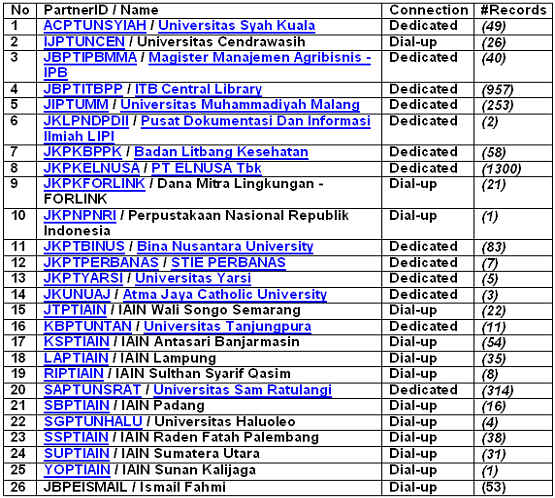
The
location of Universitas Syah Kuala (ACPTUNSYIAH) is at western of Indonesia,
while Universitas Cendrawasih (IJPTUNCEN) is at eastern of Indonesian, as shown
by figure 7. They are separated by thousands of islands each other. Universitas
Sam Ratulangi and Universitas Haluoleo are located out side of Java, while other
institutions are in Java. Dana Mitra Lingkungan (JKPKFORLINK) is a sample of
partner that installs its GDL server behind proxy.
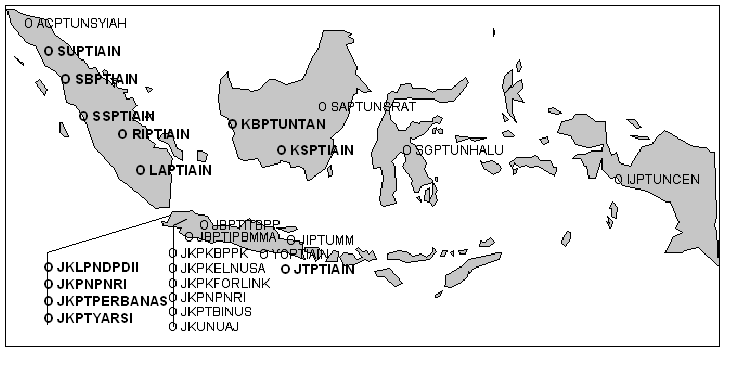
Figure
2.
The Distribution Map of IndonesiaDLN Partners
At
the end of the table, we can see a sample of Personal application of GDL. Author
(JBPEISMAIL/Ismail Fahmi) makes experiment with the installation of GDL on his
notebook; uploading his papers, articles, and other resources into his local
server. Periodically using dial-up connection, he synchronizes the collections
with the GDL-Hub in order to his electronic collections can be disseminated and
accessed widely.
From
above table we can conclude that the connection –dial-up or dedicated- is not
the barrier in sharing and accessing the electronic collections. Every partner
can download all others collections into its local server for further accesses
of its community.
In
our publisher database, actually there are 60+ registered partners. They are in
progress of developing digital library servers before can share their electronic
collection with IndonesiaDLN.
Number
of partners is keep growing. It is indicated by many institutions that have
expressed their interest to develop digital library and join IndonesiaDLN.
GDL go International
We
believe that in the
future, GDL can be implemented by other institution world wide especially at the
developing countries. Currently an NGO from Pakistan has installed the GDL for
their own purpose. This fact bring an idea of developing digital library network
among the developing countries. We also have discussed with the Penang Library
Network about the possibility of developing Indonesia-Malaysia Digital Library
Network.
Profile
of the Electronic Collections
IndonesiaDLN
manages many types of resources. The following table describes the types that
currently shared in the network. It appears that gray literature, research
reports, theses, and proceeding are the most published resources.
Table
2.
Type of IndonesiaDLN electronic resources

There
is an interesting fact. We found that the undergraduate works only stand at
seventh rank. Compared with table 5, number of undergraduate students stands at
the first rank. It is caused by an opinion that undergraduate works are not
worth enough to be published in the digital library or shared publicly.
Probably
we should change the opinion regarding to the fact that most of the digital
library users are from undergraduate students. It is often that we found many
undergraduate works have good quality and are valuable.
Profile
of IndonesiaDLN Members
A
Member is an individual that has registered to a digital library server. User
has to register in order to get full access to the digital library server. As a
guest, user can’t download the full texts.
GDL
supports roaming membership. It means user can register at any digital library
servers and use the same account to login to any GDL servers that are connected
to GDL-Hub.
Table
3 describes number of members from each Partner. JBPTITBPP –number one in the
rank- is the oldest digital library server published by ITB Central Library.
From this table we can see some Partners such as JIIYPIA and JBPTITBPSUD are in
the list. They have successfully installed GDL servers and connected to the GDL-Hub,
but they haven’t shared any information.
Table
3. The distribution of members by
Partners
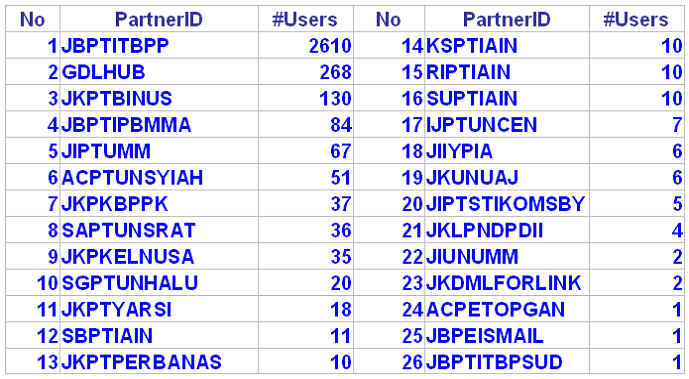
Table
4 shows countries from where the members are coming from. Most of the members
are from Indonesia. But it is interesting that 113 members (3,7%) are coming
from out side of Indonesia.
Table
4.
Members according to their countries
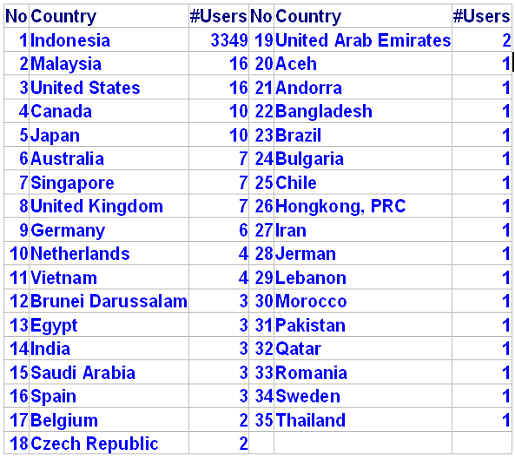
Table
5 describes the job type of members. Most of the members are undergraduate
students and other positions that are mostly at research and education
institutions. It is interesting that members from private company stand at
second rank. It shows that they need to find research information from
university and it will open future cooperation between universities community
with the private sectors.
Table
5.
Members according to their jobs
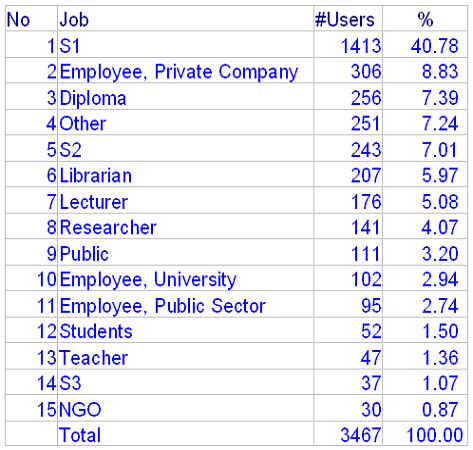
Second Half Year Plan
During the period of 25th November 2001 - 24th July 2002 we plan to conduct
the following activities:
- Improve the code of GDL to be an object-oriented application.
- Developing the GDL-Engine.
- Implementing the Open Archive Initiative Protocol into the GDL-Engine.
- Developing metadata standards for information from other subject, such as
agriculture and heritage.
- Developing the application for Electronic Theses and Dissertation above
the GDL-Engine.
- Developing the application for SME Information Network (agriKnow) above
the GDL-Engine.
- Developing the application for Heritage above the GDL-Engine.
- Cooperation with PT Naver Indonesia to install the most powerful search
engine for IndonesiaDLN.
- Cooperation with PT MyohDotCom Indonesia to include GDL into their
Warintek 9000 program.
- Hold the 3rd Meeting of IndonesiaDLN on April 2002.
CNRG & KMRG ITB
Ismail Fahmi, ismail@itb.ac.id






